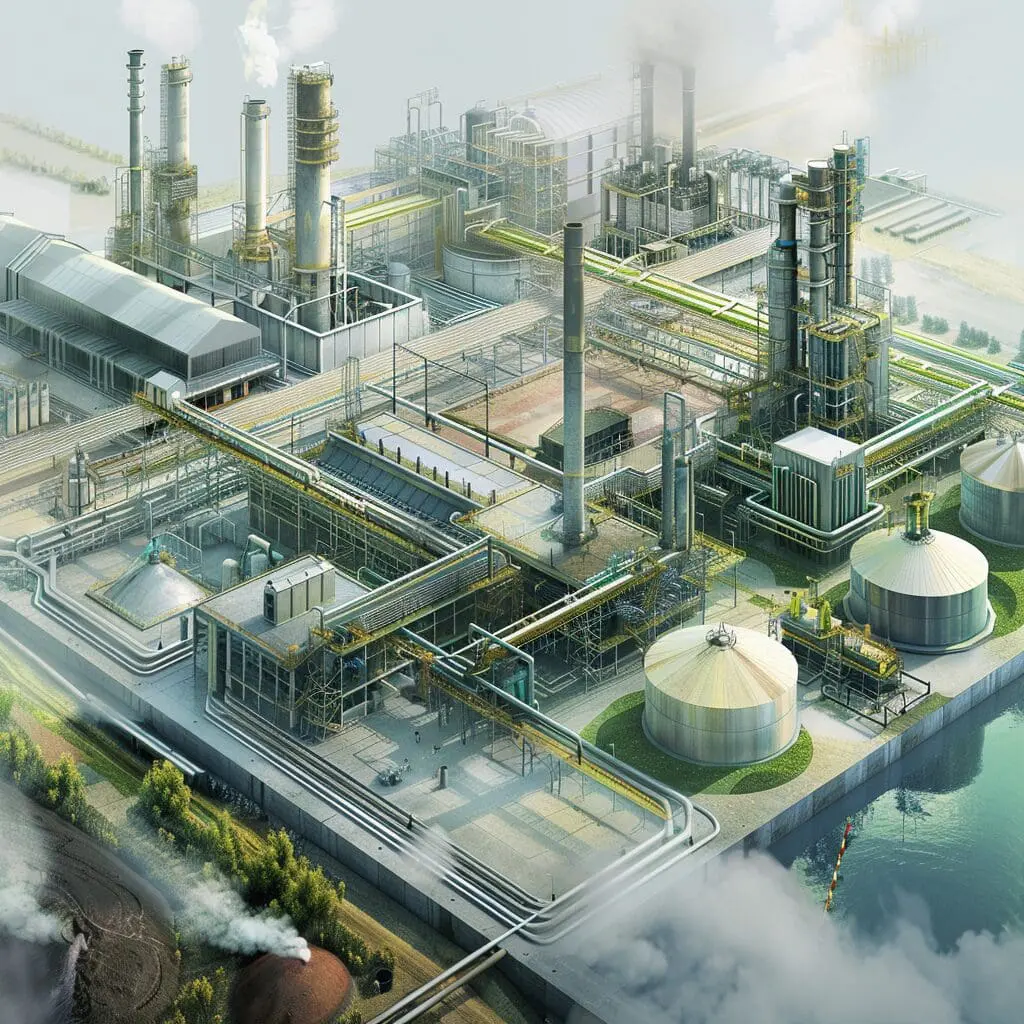

In an era dominated by the looming threat of climate change, a revolutionary advancement has been made by scientists at Heriot-Watt University. They have developed a cutting-edge material that surpasses the carbon storage and capture capabilities of trees, marking a significant milestone in our fight against climate change. This innovative material excels at absorbing carbon dioxide and sulphur hexafluoride, substances commonly emitted by fossil fuel power plants and various industrial processes, more effectively than natural solutions. It stands as a testament to the significant progress at the confluence of technology and environmental science. This achievement is the result of a collaborative effort between leading academic institutions, utilising advanced computer modelling and AI technologies to optimise carbon capture, even from gas reservoirs. This breakthrough highlights the essential role of technology in securing a sustainable future and offers hope in our global effort to counteract climate change, demonstrating the potential of investing in technological solutions for carbon capture and storage.
The breakthrough in discovering a new material that excels in removing carbon dioxide and sulphur hexafluoride from the atmosphere more efficiently than trees marks a pivotal moment in the fight against the adverse effects of fossil fuels on our planet. This achievement showcases the power of international collaboration, with scientists from Heriot-Watt University joining forces with experts from the University of Liverpool, Imperial College London, the University of Southampton, and the East China University of Science and Technology. Utilising advanced computer modelling and AI, these teams have pioneered a carbon capture technology that sets a new standard in direct air capture methods. This material’s development is particularly relevant for a power plant and other power generation industries looking for sustainable ways to decrease their carbon footprint through effective carbon dioxide removal. The collaboration of diverse expertise across various fields and regions emphasises the critical role of united efforts in tackling the environmental challenges our world faces. This significant advancement not only represents a major leap forward in combating climate change but also redefines the impact of technology and scientific research in leading the charge towards more sustainable ecological practices.
The significance of computational studies and artificial intelligence in combating climate change, particularly in reducing carbon emissions, is profound. These technologies enable scientists to predict the assembly of molecules, leading to the development of materials aimed at environmental sustainability. An example is the creation of carbon-absorbing materials by Heriot-Watt University researchers, which showcases how computer modelling and AI can revolutionise the approach to environmental challenges. These materials are crucial for capturing greenhouse gases from sources such as existing power plants, enhancing oil recovery in oil and gas reservoirs, and directly removing carbon dioxide from the atmosphere. This innovative method not only speeds up the discovery of new materials but also deepens our comprehension of their application in reducing carbon emissions. By merging computational studies with environmental science, we are moving towards more sustainable solutions and making significant progress in our efforts to address climate change.
Artificial Intelligence (AI) is transforming material science, leading the charge in developing renewable energy technologies and methods to remove carbon dioxide from the environment. By analysing extensive datasets, AI enables more accurate predictions, accelerating innovation in carbon capture techniques. A notable achievement in this field is the creation of a material capable of absorbing carbon from the air, a product of collaboration among renowned universities. This development is a significant step forward in reducing greenhouse gas emissions and combating climate change. Specifically, AI’s role in advancing carbon capture technology is crucial for filtering carbon dioxide directly from industrial flue gases at power plants and natural gas processing plants. This technology not only helps in capturing and storing carbon dioxide at designated storage sites but also marks a significant shift away from fossil fuels towards cleaner energy sources. The integration of AI with material science heralds a new era where technology enhances our ability to address environmental challenges, moving us closer to a future where renewable energy and sustainability are intertwined.
The leap from theoretical computer models to concrete, real-world applications marks a crucial evolution in addressing societal challenges. This is particularly evident in the realm of carbon capture and storage, where the development of advanced materials for capturing carbon directly from flue gas in power plants and other industrial processes has become a priority. A team at Heriot-Watt University, in collaboration with global partners, has made a breakthrough in creating a material that not only excels in absorbing carbon more efficiently than trees but also applies to enhanced oil recovery and storage in gas reservoirs. By harnessing advanced computer modelling and AI, this initiative not only confronts a critical aspect of climate change through direct air capture but also demonstrates the transformative impact of technology on societal health and sustainability. This transition from virtual models to practical applications emphasises the vital role of technology in crafting sustainable solutions for global challenges, proving that the connection between computational innovation and tangible environmental solutions is not only possible but already in progress.
The recent advancements in material science and AI, including the development of a carbon-absorbing material by the Heriot-Watt University team, signal a promising era for ecological balance and power generation. This innovation not only contributes to the green future of our planet but also opens new avenues for enhancing the efficiency of oil and gas reservoirs. Integrating this material into the infrastructure of power plants can revolutionise the way we approach energy production, especially when combined with Integrated Gasification Combined Cycle (IGCC) systems. Such advancements underscore the potential of CCS (Carbon Capture and Storage) technology and direct air carbon capture in mitigating climate change impacts. This significant leap demonstrates that technology is not merely a tool for progress but a vital force in driving us towards a sustainable world. By overcoming the natural limitations of traditional environmental solutions, these technological breakthroughs pave the way for innovative approaches to climate change mitigation, including more efficient energy production and reduced emissions in oil and gas industries. The shift towards incorporating technological innovation with environmental stewardship offers a blueprint for future generations, showcasing that a symbiotic relationship between human advancement and the natural world is achievable. Through these collaborative and interdisciplinary efforts, the role of technology in fostering a greener world transitions from a hopeful vision to an attainable reality, marking a new chapter in power generation and environmental protection.
The groundbreaking work by the team at Heriot-Watt University, along with their international collaborators, has highlighted the critical role of investing in technology, such as CCS (Carbon Capture and Storage) technology, to achieve a sustainable future. The development of materials that can capture flue gas emissions from power plants more efficiently than natural processes is a testament to the potential of technological innovations in addressing environmental challenges. This effort aligns with the goals of the Global CCS Institute and the International Energy Agency, emphasising the importance of identifying suitable storage sites for CO2 captured from power plants. By combining the prowess of computational science and material engineering, this collaboration acts as a vital step towards the adoption of CCS technology on a global scale. It underlines the pressing need for individuals and organisations worldwide to support and invest in technologies that not only mitigate climate change effects but also contribute to ecological restoration. As we step into an era where science and sustainability converge, bolstering initiatives like CCS technology becomes imperative to redefine our environmental legacy and secure a greener, more thriving future for our planet.
The intersection of science and technology, especially within the realms of artificial intelligence (AI) and material sciences, marks a revolutionary stride towards addressing climate change. This is vividly illustrated through the strategic use of AI and computer modelling in enhancing industrial processes, including those at power plants. One notable achievement is the development of carbon capture technology, which includes post-combustion capture methods that are vital for reducing emissions from existing power plants. The creation of a novel carbon-absorbing material by the Heriot-Watt University team stands as a testament to these efforts. This material could be utilised at power plants and other industrial sites as part of a comprehensive carbon capture and storage strategy. Such innovations underscore the potential of AI to revolutionise traditional approaches, paving the way for more efficient storage sites and assisting in the transition to cleaner industrial processes. By effectively merging theoretical research with practical implementation, these technological advancements not only aim to curb the impacts of climate change but also embody the potential for a harmonious relationship between technological progress and environmental preservation.
The search for innovative solutions to reduce greenhouse gas emissions from power plants is propelling scientists and researchers to harness the untapped potential of new materials using advanced computer modelling. This pioneering method, illustrated by the team at Heriot-Watt University, employs artificial intelligence (AI) and computational science to simulate and predict the behaviour of novel materials that could optimise the efficiency of power plants before these materials are physically developed. By doing so, this approach not only speeds up the discovery process but also cuts down significantly on the resources and time traditional experimental trials demand. Advanced computer modelling is thus emerging as a critical frontier in the fight against climate change, aiming to discover materials that could revolutionise how power plants operate and substantially lower greenhouse gas emissions, thereby contributing to our sustainability objectives.

This website uses cookies to improve your experience. Choose what you're happy with.
Required for the site to function and can't be switched off.
Help us improve the website. Turn on if you agree.
Used for ads and personalisation. Turn on if you agree.
This website uses cookies to improve your experience. Choose what you're happy with.
Required for the site to function and can't be switched off.
Help us improve the website. Turn on if you agree.
Used for ads and personalisation. Turn on if you agree.